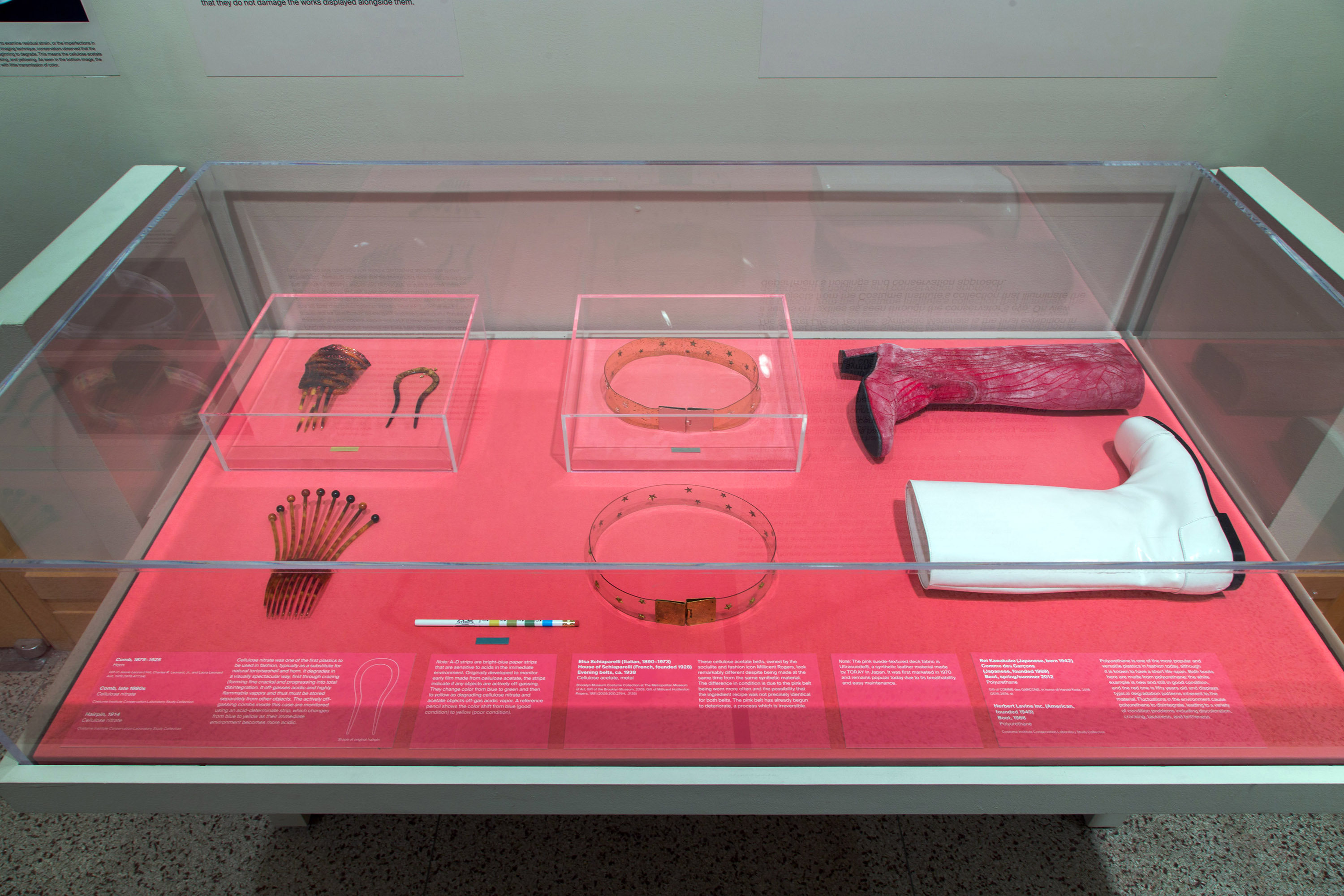Fashion, unlike art, is not expected to defy time. Designers consider a garment’s durability with the consumer in mind, in terms of seasons, maybe even years—but certainly not decades. This leaves the Costume Institute’s conservation team, then, to solve the riddle of how to preserve objects that were never built to last. The problems are diverse—from insect damage to century-old pit stains—but within that broad spectrum of difficulty, synthetic materials are in a category all their own. The exhibition description of The Secret Life of Textiles: Synthetic Materials, which opened early last month at the Met, reads like a scene from Mission: Impossible: “Due to their unstable composition, these materials have shorter lifespans than natural fibers; some actually self-destruct.” With the clock ticking, fearless investigator Sarah Scaturro, otherwise known as the institute’s head conservator, is trying to tackle the problem.

Gallery View: The Secret Life of Textiles: Synthetic Materials . © The Metropolitan Museum of Art
Scaturro recently took Creators around the exhibition she co-curated with Leanne Tonkin, a conservator who is currently studying plastics on a Polaire Weissman Fund Fellowship. The show is aptly named, considering its practically hidden location—a small gallery below the Medieval Art section. A single flight of stairs is enough to traverse the centuries: The room pops with technicolor hues and modern fashions. Against a bright pink backdrop made of ultrasuede (a microfiber invented in 1970), plastic mannequins and plexiglass cases showcase an array of synthetic garments and accessories.
Videos by VICE
“Elsa Schiaparelli is very much the muse of the exhibition,” notes Scaturro, pointing to one of the designer’s dresses made of rayon. “She was one of the first designers to really embrace plastics and their aesthetics—that kind of fake, surreal quality. This dress is from 1938, but the explosion of plastics really happened after World War II.” The Schiaparelli ensemble hangs alongside a polyester dress from the late 60s, designed by Rudi Gernreich. “Polyester was a miracle when it came out: You didn’t have to dry it, you didn’t have to iron it. It was the fiber for the modern woman,” the conservator tells us.

Gallery View: Performance. © The Metropolitan Museum of Art
The objects on view were chosen to evoke the two main reasons plastics are so prevalent in fashion: aesthetics and performance. “Designers are drawn to these fantastic materials that can be flexible yet clear, appear metallic without tarnishing… And then there’s performance: For the first time you had a material that mimicked wool, but didn’t shrink in the dryer or get eaten by moths. It was easy to care for and comfortable; it moved with your body,” summarizes Scaturro. She points out a few of the objects that organized her thinking: The “Invisible Sandal” by Salvatore Ferragamo, from 1947, was made with a single clear nylon thread that runs through the leather sole. Over in the performance-themed case, the label on a girdle from the 1950s (a.k.a. “proto-Spanx,” Scaturro jokes) reads “I owe it all to Goddess.”

Gallery View: Inherent Vice. © The Metropolitan Museum of Art
Nuancing this celebration of plastics is the “scary case,” with hair combs, belts, and shoes that are quietly self-destructing, and tell the story of just how problematic plastics can be as they age. When objects deteriorate in this way, simply because of instabilities in their material makeup, conservators speak of “inherent vice.” Three afflicted plastics commonly found in fashion collections are cellulose nitrate, a flammable substance mainly used in the late 19th and early 20th centuries; cellulose acetate, which came to replace cellulose nitrate but isn’t so common anymore, except in sunglasses; and polyurethane, which is “surprisingly prevalent, often in blends of different plastics,” notes Scaturro, looking concerned. “That might be a hidden time bomb that people don’t recognize is in their collections.”

Deterioration on Herbert Levine polyurethane boot from 1966, part of the Costume Institute conservation lab’s study collection. Photo by the author.
Several objects in this case are sequestered from the others because they are malignant, meaning they are off-gassing acidic vapors into the environment. This is the case of two cellulose nitrate hairpieces that have cracked. Nearby, a red polyurethane boot by Herbert Levine, whose original faux patent leather appeared as a uniform layer in the 60s, now has a bad case of “elephant skin,” with severe cracks all along the surface. Many objects here, including the boot, have been deaccessioned by the museum and are now part of the conservators’ study collection. “I think most conservation labs have a wonderful study collection of scary things—for research, study and practice,” says Scaturro.


Two evening belts (viewed through linear polarized light) by Elsa Schiaparelli, circa 1938. Cellulose acetate and metal. Brooklyn Museum Costume Collection at The Metropolitan Museum of Art, Gift of the Brooklyn Museum, 2009. © The Metropolitan Museum of Art
Two nearly identical Schiaparelli belts made of cellulose acetate, both from the same 1938 collection and both from the same donor, make for a compelling comparative study. One has aged remarkably well, while the other is severely warped and cracked. The extent of the damage is especially visible when viewed under polarized light: “Unfortunately, these beautiful, refractive colors are indicative of where the polymer is beginning to break down,” says Scaturro, who has two hypotheses. The belts could have been from different batches, with one recipe proving more stable than the other—or it could be that the original owner favored one of the belts, and what we are seeing is the residual strain from years of wear.
An object’s prior life has a lot to do with how it will age, and this is one of the reasons that the contemporary objects that are now acquired directly from the designers, never before worn, are at a distinct advantage. The other is simply age: “All plastics have an induction period—they’re totally fine for a while, and you never know how long that’s going to last, and then all of a sudden they just go,” says the conservator. “It’s sad to say, but a lot of our plastics from the early and mid-20th century are on borrowed time—they’re nearing the end of their induction period.” While discussing a pair of Courrèges sunglasses from 1965, which are starting to warp, she admits, “These are probably going the way of the belt.”
Inherent vice cannot be reversed, so conservators focus mainly on extending an object’s induction period for as long as possible—and early intervention is key. “A lot of my research is focused on contemporary plastics coming into the collection now. I have the greatest potential of doing good now, so that these fabulous plastics can last 50 to 100 years in the future.” Unfortunately, the work ahead is labor-intensive: Objects must undergo extensive analysis, because their composition is what determines which storage strategy to use. For example, if an object is made of an ether-based polyurethane, it’s more susceptible to oxygen, and should be stored in anoxia. If it’s an ester-based polyurethane, it will survive longer in low humidity.

André Courrèges dress from 1968, made of cellulose acetate, silk and cotton. © The Metropolitan Museum of Art
This is all uncharted territory, however, and conservators can’t know for sure how an object will react—especially if it is made of a blend of several plastics, or if other materials are present. Take this as one example: The 60s Courrèges dress in the center of the exhibition was made with large circles of cellulose acetate, which are becoming brittle and warping. We know from the analog film industry that cellulose acetate does well in cold storage. “But it’ll shrink a certain amount in storage, and expand a certain amount once it comes out to be displayed,” explains Scaturro. “Over time, what kind of tension will that put on all the joints and the zipper—and will that actually do more damage?”
At this stage, there are more questions than answers, and with over 4,000 objects in the Costume Institute collection featuring some kind of plastic component, Scaturro knows that more research is desperately needed. Still, she remains optimistic: “People ask, ‘Should we even be collecting plastics if we know they’re going to degrade?’ I think certainly we should. Synthetics are such an important part of contemporary fashion that not collecting them would be even more problematic. It’s up to me and my team to figure out how to make this work, and I think we can.”

Gallery View: Aesthetics. © The Metropolitan Museum of Art

Gallery View: Performance. With bathing trunks by Pierre Cardin, spring/summer 1975, and another pair by Jantzen, 1930–49. © The Metropolitan Museum of Art
The Secret Life of Textiles: Synthetic Materials is on view at The Met Fifth Avenue through September 4, 2017. The two previous exhibitions in this series, also curated by conservators, highlighted plant fibers and animal fibers.
Related:
Go Behind the Scenes of the Met’s Costume Institute | Conservation Lab
To Save Dorothy’s Red Slippers, It May Take a Wizard | Conservation Lab
Weave Your Way Through Magnified Photos of Fabric | Conservation Lab
More
From VICE
-

Photo: janiecbros / Getty Images -

Photo: NATALIA ANDREEVA / Getty Images -

(Photo by John Nacion/Variety via Getty Images) -

Illustration by Reesa
